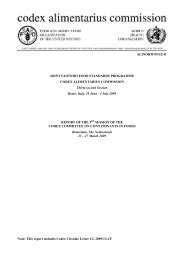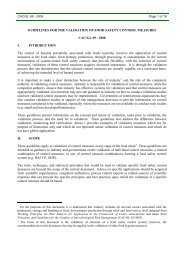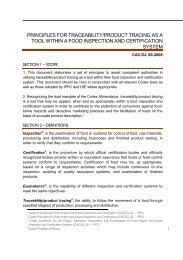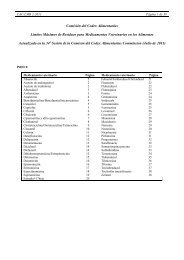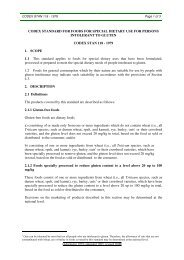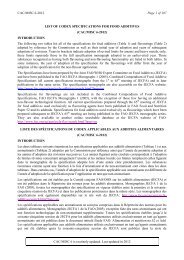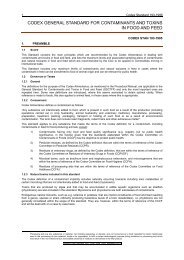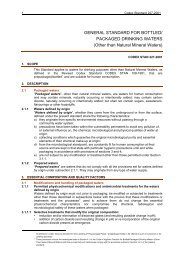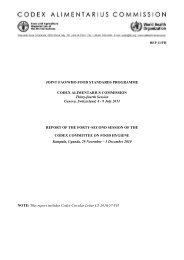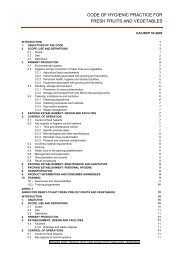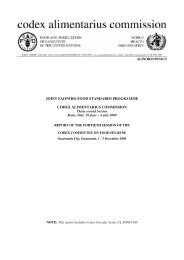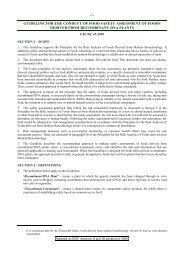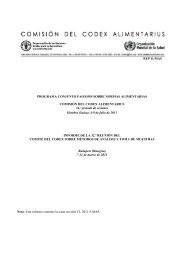General Standard for Food Additives - CODEX Alimentarius
General Standard for Food Additives - CODEX Alimentarius
General Standard for Food Additives - CODEX Alimentarius
Create successful ePaper yourself
Turn your PDF publications into a flip-book with our unique Google optimized e-Paper software.
<strong>CODEX</strong> STAN 192-1995 Page 36 of 287<br />
down in soy sauce (tsukudani); cooked surimi product (kamaboko); crab-flavoured cooked kamaboko<br />
product (kanikama); cooked fish roe; cooked surimi; cooked, tube-shaped surimi product (chikuwa); and<br />
cooked fish and lobster paste (surimi-like products. Other fish paste (Oriental type) is found in 09.3.4.<br />
09.2.4.2 Cooked molluscs, crustaceans, and echinoderms:<br />
Cooked products include steamed, boiled or any other cooking method except frying (see 09.2.4.3).<br />
Examples include: cooked crangon crangon and crangon vulgaris (brown shrimp; cooked shrimp, clams and<br />
crabs.<br />
09.2.4.3 Fried fish and fish products, including molluscs, crustaceans, and echinoderms:<br />
Ready-to-eat products prepared from fish or fish portions, with or without further dressing in eggs and bread<br />
crumbs or batter, that are fried, baked, roasted or barbecued, and then packaged or canned with or without<br />
62<br />
sauce or oil. Examples include: ready-to-eat fried surimi, fried calamari, and fried soft-shell crabs.<br />
09.2.5 Smoked, dried, fermented, and/or salted fish and fish products, including molluscs, crustaceans, and<br />
echinoderms:<br />
Smoked fish are usually prepared from fresh deep frozen or frozen fish that are dried directly or after boiling,<br />
with or without salting, by exposing the fish to freshly-generated sawdust smoke. Dried fish are prepared by<br />
exposing the fish to sunlight or drying directly or after boiling in a special installation; the fish may be salted<br />
prior to drying. Salted fish are either rubbed with salt or placed in a salt solution. This manufacturing<br />
process is different from that described in food category 09.3 <strong>for</strong> marinated and pickled fish. Cured fish is<br />
62<br />
prepared by salting and then smoking fish. Examples include: salted anchovies, shrimp, and shad; smoked<br />
chub, cuttlefish and octopus; fish ham; dried and salted species of the Gadidae species; smoked or salted fish<br />
paste and fish roe; cured and smoked sablefish, shad, and salmon; dried shellfish, dried bonito (katsuobushi),<br />
and boiled, dried fish (niboshi).<br />
09.3 Semi-preserved fish and fish products, including molluscs, crustaceans, and echinoderms:<br />
Includes products treated by methods such as marinating, pickling and partial cooking that have a limited<br />
shelf life.<br />
09.3.1 Fish and fish products, including molluscs, crustaceans, and echinoderms, marinated and/or in jelly:<br />
Marinated products are manufactured by soaking the fish in vinegar or wine with or without added salt and<br />
spices. They are packaged in jars or cans and have a limited shelf life. Products in jelly may be manufactured<br />
by tenderizing fish products by cooking or steaming, adding vinegar or wine, salt and preservatives, and<br />
solidifying in a jelly. Examples include: “rollmops” (a type of marinated herring), sea eel (dogfish) in jelly<br />
62<br />
and fish aspic.<br />
09.3.2 Fish and fish products, including molluscs, crustaceans, and echinoderms, pickled and/or in brine:<br />
Pickled products are sometimes considered a type of marinated product. Pickling results from the treatment<br />
62<br />
of the fish with a salt and vinegar or alcohol (e.g., wine) solution. Examples include: different types of<br />
Oriental pickled products: koji-pickled fish (koji-zuke), lees-pickled fish (kasu-zuke), miso-pickled fish<br />
(miso-zuke), soy sauce-pickled fish (shoyu-zuke), and vinegar-pickled fish (su-zuke); pickled whale meat; and<br />
pickled herring and sprat.<br />
09.3.3 Salmon substitutes, caviar, and other fish roe products:<br />
Roe is usually produced by washing, salting and allowing to ripen until transparent. The roe is then packaged<br />
in glass or other suitable containers. The term “caviar” refers only to the roe of the sturgeon species (e.g.,<br />
beluga). Caviar substitutes are made of roe of various sea and freshwater fish (e.g., cod and herring) that are<br />
62<br />
salted, spiced, dyed and may be treated with a preservative. Examples include: salted salmon roe (sujiko),<br />
processed, salted salmon roe (ikura), cod roe, salted cod roe (tarako) and lumpfish caviar. Occasionally, roe<br />
may be pasteurized. In this case, it is included in food category 09.4, since it is a fully preserved product.<br />
Roe products that are frozen, cooked or smoked are included in category 09.2.1, 09.2.4.1, and 09.2.5,<br />
respectively; fresh fish roe is found in category 09.1.1.



